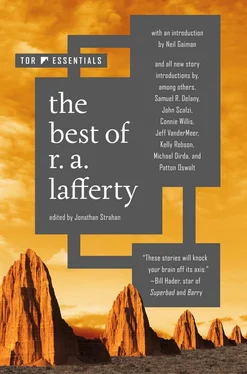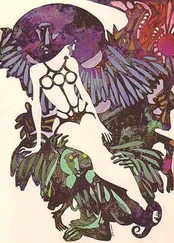He was in the army in WWII, and was sent to the South Pacific, but maintained that, at twenty-eight, he was ten years too old when this happened to properly enjoy or appreciate it.
He published his first science fiction story, “Day of the Glacier,” in Original Science Fiction Stories in 1960 when he was forty-six. “I was moderately successful,” he said of his writing. “It didn’t put me on easy street, but it put me on easy alley.”
He won the Hugo Award in 1973 for “Eurema’s Dam,” which was a good story, but he lost awards with much better stories, and some of his finest stories were never noticed by the people who nominate you for awards. He retired from writing in 1984, having published over two hundred short stories and over twenty novels.
He had a stroke in 1994, and Alzheimer’s in his final years. He died in 2002, in a nursing home in Broken Arrow, Oklahoma, twenty minutes from Tulsa.
In a brief piece he wrote to accompany a photo of himself in Patti Perret’s 1985 book The Faces of Science Fiction, he said, “When I was forty-five years old, I tried to be a writer. I became the best short story writer in the world. I’ve been telling people that for twenty years, but some of them don’t believe me.”
I believed.
It is not impossible that, once you also have read this book, you may become a believer as well.
Introduction by Michael Dirda
While loosely categorized as a science fiction writer, R. A. Lafferty was—to use the old phrase— sui generis . His stories, with their surrealist plots and breathless pace, revel in excess, parenthetical asides, and gonzo bizarreness of every sort. Lafferty fans seldom have any clear idea where his absurdist tall tales are going, but who cares? We’re here for the ride.
Think back to the first time you read a “Lafferty.” It might have been “Land of the Great Horses,” which explains the origin of the gypsies and was included in Harlan Ellison’s groundbreaking Dangerous Visions . Perhaps you happened upon “Eurema’s Dam” in an anthology of Nebula Award winners. Or just maybe you unearthed an old issue of If in a run-down charity shop and discovered “Boomer Flats,” in which a trio of eminent scientists travel to a Texas backwater in search of the missing link and there encounter hairy giants, a gorgeous woman named Crayola Catfish, a race of near immortals, and a space traveler known as the Comet.
My own introduction to Lafferty came through Gene Wolfe, back in the early 1980s. I was interviewing Wolfe about the just completed Book of the New Sun and asked him what contemporary writers he admired. He immediately answered, “R. A. Lafferty,” so I sensibly went out and bought a copy of the Ace Science Fiction Special, Nine Hundred Grandmothers . For some reason—perhaps the title attracted me—the first story I turned to was “Slow Tuesday Night.” That was enough. I read it with the same delight I had experienced when, as a teenager, I opened Lord Dunsany’s Jorkens Remembers Africa or The Most of S. J. Perelman. You know that feeling: you just want to hug yourself with pleasure, while sometimes laughing quietly or murmuring, “This is soooo good.”
No précis can convey the sheer exuberance of “Slow Tuesday Night.” Lafferty mixes courtly diction and comic-strip names, sets up expectations and immediately undercuts them, and gradually reveals a world that now seems all too familiar. In 1965, when “Slow Tuesday Night” first appeared in Galaxy, Lafferty was obviously using the American obsession with speed to critique our idolization of wealth, status, and celebrity. Read today, the story uncannily foretells the viral culture of the internet.
In its opening scene a panhandler accosts a strolling couple: “‘Preserve us this night,’ he said as he touched his hat to them, ‘and could you good people advance me a thousand dollars to be about the recouping of my fortunes?’” The diction here recalls the arch formality of W. C. Fields or Popeye’s scrounging friend J. Wellington Wimpy (“I’ll gladly pay you Tuesday for a hamburger today”). Neither the panhandler nor the couple seem to think it unusual for a beggar to ask for a thousand dollars. We soon learn why: after removing the “Abebaios block” from our brains, people found that “things that had once taken months and years now took only minutes and hours. A person could have one or several pretty intricate careers within an eight-hour period.”
Soon everything—absolutely everything—goes much, much faster, which also means that nothing lasts for very long. That panhandler—his name is Basil Bagelbaker—“would be the richest man in the world within an hour and a half. He would make and lose four fortunes within eight hours; and these not the little fortunes that ordinary men acquire, but titanic things.”
In the course of a single evening, Ildefonsa Impala, the most beautiful woman in the city, marries again and again. Her honeymoon with newly rich inventor Freddy Fixico is utterly kitsch—“the reticulated water of the famous falls was tinted gold; the immediate rocks had been done by Rambles; and the hills had been contoured by Spall.” After a luxurious hour, Ildefonsa consults “a trend indicator” and realizes that Freddy’s invention would soon be outmoded and his wealth gone, so she immediately divorces him. “Whom shall I marry next?” Ildefonsa asks herself on this slow Tuesday night.
Meanwhile, Basil has been wheeling and dealing in the Money Market. “He caused to collapse certain industrial empires that had grown up within the last two hours, and made a good thing of recombining their wreckage.” Naturally enough, his wife, Judy, is chosen “one of the ten best-dressed women during the frou-frou fashion period about two o’clock.” In such a mayfly world, plays and films run no longer than six minutes and Stanley Skuldugger can be voted “the top Actor-Imago of the middle hours of the night.” Having decided to produce a philosophical masterpiece, Maxwell Mouser is willing to devote an entire seven minutes to the task. He turns to “the ideas index,” sets the “activator” for the amount of wordage needed, and, for that extra bit of sparkle, switches on a “striking analogy blender” calibrated to his particular “personality-signature.” The resulting monograph quickly goes viral—“This was truly one of the greatest works of philosophy to appear during the early and medium hours of the night”—but by dawn it will already be dismissed and forgotten.
In “Slow Tuesday Night” Lafferty—politically conservative and devoutly Catholic—depicts a society of meaningless flux and impermanence, where there is “no abiding city” nor any sense of the spiritual. People surrender to the passing moment, nothing seems to matter very much, no hearts are permanently broken. Yet all this meretricious shallowness is conveyed through a simple yet brilliant conceit: if you speed up the world enough, everything starts to resemble the frenetic climax of a Keystone Kops farce.
In “Seven-Day Terror” Lafferty mentions “an untidy suite that looked as though it belonged to a drunken sultan.” That’s a wonderful simile, but also a fair description of his own gorgeous, shambolic abundance. What we love about Lafferty’s stories is the joyfulness of their telling, the playful diction, the topsy-turvy plot surprises, the knowing winks. To expect from them any logic but that of Wonderland is to miss the party. After all, as the Rabelaisian hero of “One at a Time” says, if you insist on realism and perfect sense, “you put unnatural conditions on a tale.” I’m pretty sure his creator would agree.
Читать дальше




![Рафаэль Лафферти - Дни, полные любви и смерти. Лучшее [сборник litres]](/books/385123/rafael-lafferti-dni-polnye-lyubvi-i-smerti-luchshe-thumb.webp)
![Рафаэль Лафферти - Лучшее [Сборник фантастических рассказов]](/books/401500/rafael-lafferti-luchshee-sbornik-fantasticheskih-ra-thumb.webp)